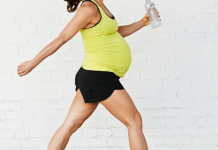Practicing Prenatal Yoga is an excellent way to prepare the body for labor and delivery. Asana, the Sanskrit word for the physical postures, can help to ease tension in the body, manage common aches and pains in shoulders, low back, hips, etc that are often associated with pregnancy. Postures will also build strength, stability and stamina which mom-to-be will need for labor & delivery. Prenatal Yoga, especially pranayama (the Sanskrit word for the techniques to connect to the breath) and meditation can help the mom-to-be relax and destress, particularly when feelings of fear and anxiety creep in about childbirth and motherhood. Above all, yoga also helps the mother become more attune with herself, and the growing life within her.
Due to the uniqueness of our bodies, there is no one-size-fits-all prenatal yoga practice. As a prenatal yoga teacher, I have 5 postures that I consider to be the most effective for most pregnant woman to help her manage the common physical discomfort of pregnancy, but to also prepare her body for labor and delivery, and to recover postpartum. In my prenatal yoga classes, I often point out these postures and refer to them as yoga homework for my students.
Cat & Cow Vinyasa – These are actually two very distinct and unique postures. Cow pose is a backbend, while Cat Pose is a forward fold. In a typical yoga class, Cat & Cow are Vinyasa Postures, or to coordinate movement with breath to flow from one pose to the next. For the sake of my “5 Postures,” I am grouping them together. Cat & Cow keeps the spine supple and alleviates low back discomfort. It helps to broaden the pelvic bowl to prepare the body for labor. Engaging the pelvic floor keeps those muscles strong which will assist in the pushing action of labor, and is important for postpartum recovery. In the final weeks of pregnancy, Cat/Cow Vinyasa encourages baby to get into position. It can also be useful to encourage a breech baby to flip! Come to hands and knees, tabletop (use a blanket or towel under the knees if they feel sensitive to pressure and if a mat is not available). Draw the belly upwards so baby feels nicely supported and engage through the pelvic floor (think about your Kegels). Take several deep breaths in and out through the nose while maintaining a neutral spine. On an inhale breath move into Cow Pose, tilting the pelvis so that the tailbone is moving towards the sky. As you do this, the belly softens towards the floor and the heart presses forward, as your gaze goes up. Use the full length of the inhale to get there. Exhale to move into Cat Pose, tilting the pelvis so that the tailbone is moving downward towards the ground, the back of the heart presses upwards and the chin draws to the chest. Use the full length of the exhale to get to there. Move at your own breath pace from Cow to Cat. Let the breath be deep and slow. Don’t rush from one pose to the other. Repeat for at least 5 rounds.
Child’s Pose (Balasana) – This posture gives a good stretch to the spine, decompresses the lower vertebrae, and opens up the hips. To come into Child’s Pose, begin in tabletop with the tops of the feet on the floor (toes should be untucked), bring the big toes together to touch, and separate the knees wide. The hips move back & down to the heels, walk the hands forward and lower the belly and the heart towards the floor. The belly should not be resting on the thighs, so if it does, separate the knees further. If it feels good to straighten the ams all the way out, do that. Otherwise, stay slightly elevated by resting on the forearms. A blanket or towel can be used under the hips if they feel tight and if they don’t rest comfortably on the heels. A bolster or pillow can also be used under chest for support. Please avoid any compression on the belly in this pose. Stay here for 10 breaths or more and come up very slowly.
Warrior 2 (Virabhadrasana B) – This standing pose is excellent for strengthening the legs and building stability in the hip flexors. Yoga is not just about flexibility and due to the relaxin hormone, it’s best to not stretch too deeply. Labor and delivery of a baby is on the same level of physical exertion as running a full marathon, so mama must be prepared! Warrior 2 and other standing yoga poses will give that strength and stability needed for the big day, but also along the way as the joints and ligaments that surround them naturally become more lax. Begin with the feet widely separated, hips and shoulders facing the long edge of the yoga mat. Turn the right foot out to the short edge of the yoga mat and the toes on the left foot are facing the long edge and turned slightly inward. Arms reach out wide, shoulder height. Take and inhale and on the exhale breath, bend into the right knee, keeping the knee inline with the ankle. Keep the hips and shoulders facing the long edge of the mat and turn the head to look past the right hand. Ground into the right heel to engage the legs further. Hold for 5 full and complete breaths. Inhale and straighten the right leg, pivot the feet and do the pose on the left side for 5 breaths.
Yogi Squat (Malasana) – By now the hips will be nice and open and the body has loosened up a little bit. This is one of the best poses to do throughout pregnancy as it quite literally is the posture of birth. Knees are wide and come up high towards the underarms. Whether the mother is delivering from a hospital bed, birthing tub or squatting, this is the general position taken when baby emerges. Practice this pose along with breathing techniques to allow the body to settle into the shape. Squat with feet slightly wider than hip distance apart, the thighs are wider than the torso to make space for baby. Press elbows against inner knees and hands come together at the heart. Soften the tailbone towards the floor and reach the crown of the head to the sky, creating a long spine. Breathe slow and deep 10 cycles and build up to about two minutes. A rolled blanket or towel can support the heels if they do not rest on the floor. A bolster or yoga block can support under the hips. If those items are not available at home, a small stool can help. Use the time spent in this pose to connect to breath, to baby and to your inner strength and power.
Savasana – The most important pose! This is the posture of rest and rest is NOT a luxury, my dear mama. It is mission critical to your health and well being. I know we all have things to do and the list seems to never end. But we are not a never-ending well of energy. Stop everything that you’re doing and rest for 7 minutes. Go for 10! Lay down and be still to quiet the mind. After moving the body in the previous 4 poses, the energy in you has been rearranged so that you can find the stillness needed to surrender and let go. In this pose, no work or effort is required of you. There’s nothing to do, nowhere to go, nothing to be, than to just simply be. Lay down on the floor with one pillow under your head and another under the knees. If laying on the back is not comfortable, lay on the left side and put a pillow between the legs. Supreme rest.
A consistent yoga practice throughout pregnancy is so beneficial to a mom-to-be. Even if she has never practiced yoga before, this is a great time to start. You can find me teaching prenatal yoga at Modern Milk Scottsdale on Tuesday mornings and Wednesday evenings, and Vinyasa Flow on Friday mornings. There is even childcare available for the morning classes!


















